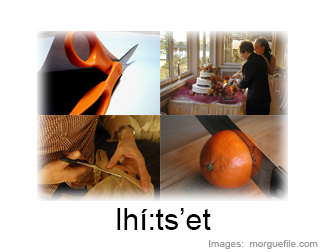Lhí:ts’et is the Halq’eméylem word for ‘to cut (it)’.
Pronunciation
Lhí:ts’et sounds like LEE-tsut, except that:
- The first sound is not regular l, but the hissy lh. To make this sound, say an l but with more friction, and no vibration in the throat.
- Note that you also say a glottal stop after the ts (ts’).
Audio: Elizabeth Herrling, Elizabeth Phillips
Pronunciation
Here are some examples of how you can use lhí:ts’et:
- Tsel lhí:tset te pipe. – I cut the paper.
- Tsel lhí:tset te sméyeth. – I cut the meat.
- Tsel lhí:tset. – I cut it. (‘it’ is understood, here)
Note: if you don’t say specifically what you cut, speakers will understand ‘cut it‘, as in the last example above.
-ing form
To talk about cutting as an ongoing action, you use a special form of lhí:ts’et, like this: lhílhets’et – cutting (audio here).
Related words
Here are some other words related to lhíts’et:
- lhá:ts’tel – knife (the -tel ending marks tools, devices)
- lhíts’eqwt – to cut (his/her) hair (the -eqw ending marks of the head, hair)
- slhíts’es – wind-dried salmon (the -es ending marks face, surface, so this is literally ‘with cuts on the surface’)




No comments yet.